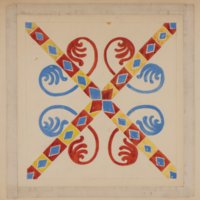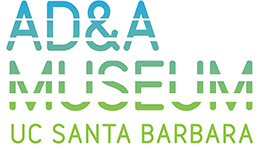Browse Exhibits (9 total)
Irving J. Gill: Simplicity and Reform

Irving J. Gill (1870-1936) is known for his refined and abstracted architectural vocabulary, which he described as “the straight line, the cube, the arch, and the circle.” His deceptively simple forms first began to appear in his California work in 1903; his most significant and mature designs date from 1907 through 1920.
This exhibition (on display at the Art, Design & Architecture Museum from September 2016 until December 2016), was the first major view of Gill’s work since Esther McCoy’s exhibit at the Los Angles County Museum of Art in 1958. It traces the roots of his architectural language to the social concerns of the Progressive era and the Arts and Crafts movement, and especially the influence of Chicago architect Louis Sullivan (1856-1924), whose passionate ideas about architecture were linked to a transcendental view of Nature, borrowed from the essays of Ralph Waldo Emerson (1803-1882) and the poetry of Walt Whitman (1819-1892).
Sullivan argued for a “new architecture in America” based on Nature and unaffected by the past or European trends. Gill carried Sullivan’s ideas with him to California when he left the Adler and Sullivan office in 1893, and by 1903 was developing his own simplified, distilled, formal vocabulary. He married his abstract forms-- based on the straight line, the cube, and the circle--to experiments in materials and construction that he hoped would fulfill the need for sanitary, fireproof homes and inexpensive ways to build for the poor and working class.
The exhibition in 2016 was curated by Jocelyn Gibbs, then-Curator of the Architecture and Design Collection, and now Curator Emeritus.
Lucile Lloyd: A Life in Murals

Drawn from the Lucile Lloyd Papers at the University of California, Santa Barbara Architecture and Design Archive, Lucile Lloyd: A Life in Murals offers a rare look at a prolific yet understudied artist. During the Great Depression, Lucile Lloyd (1894-1941) built an active career as a mural decorator. Her richly-colored scenic murals and stenciled patterns adorned the interiors of homes, schools, restaurants, shops, and public buildings. Lloyd began her career in New York, and in 1919 relocated to the Los Angeles area. Murals were at a height of popularity. Hand-painted ornament was fashionable in homes and public buildings alike, and the Works Progress Administration (WPA) funded public murals to ease unemployment during the Depression. In 1935, Lloyd became the first woman artist in Southern California to receive a prestigious WPA commission. The resultant mural, California’s Name, was her last major project.
Since Lloyd’s death in 1941, many of her murals have been lost. The mode of decoration she practiced, however, is a hallmark of the Spanish Revival and Art Deco styles of architecture popular during the 1920s and 30s, of which numerous examples remain. The Lucile Lloyd Papers, therefore, give insight into a forgotten trade and the tastes, values, and building practices in Southern California and the United States during the 1920s and 30s.
UCSB Campus Architecture: Design and Social Change

UCSB Campus Architecture: Design and Social Change presents a chronological view of the planning and design of the UCSB campus, tracing architectural styles and social change through master plans, drawings, photographs, models, and ephemera from the Museum’s Architecture and Design Collection.
The Architecture and Design Collection contains over 250 architectural collections and archives, with a focus on southern California from the late 19th through the early 21st century. The University of California, Santa Barbara Campus Building Records collection forms the basis of this exhibit. The collection brings together materials donated to the ADC by the UCSB Library Special Collections, the office of the Associate Campus Architect (Dennis Wheelan), and the Vice Chancellor of Administrative Services (Marc Fisher). Additionally, over 20 other ADC collections were used to add additional content since the UCSB campus contains many buildings designed by ADC architects.
J.R. Davidson: A European Contribution to California Modernism

This is a digital version of the exhibition which was held in Fall 2019 at UCSB's Art, Design & Architecture Museum.
J.R. Davidson (b. Germany, 1889-1977), architect of the Thomas Mann House (1941), and three prototypes for the Case Study House Program (1946-48), contributed his European background, and specifically his training in interior design, to the advancement of modernism in Southern California. Throughout his five decades long career, Davidson produced an architecture highly functional in its plan, yet sensitive to its natural surroundings in its elevations. Despite the achievements that Davidson attained in his professional life, he remains an understudied figure in the history of modern architecture. This exhibition, organized with materials from the architect's archive at the Architecture and Design Collection of the AD&A Museum, fills this gap by highlighting those aspects of Davidson's trajectory that were unique to his way of understanding architecture and its practice. These include, for example, the way Davidson conceived architecture from the inside out and the integration of the outside in through large-scale windows. Photographs, notebooks, manuscripts, and drawings document, in the exhibition, the prolific career of the German emigre bringing it to a new standing and recognition.
J.R. Davidson, A European Contribution to California Modernism is curated by architectural historian Lillian Pfaff, who is also the author of the illustrated monograph on Davidson.
Carefree California: Cliff May and the Romance of the Ranch House

The Art, Design & Architecture Museum presents the first major exhibition based on the work of Cliff May, the designer who popularized the ranch house and made it an icon of casual California living in the post-war era. The exhibition was co-curated by Jocelyn Gibbs, Curator Emeritus of the AD&A Museum's Architecture and Design Collection, and historian Nicholas Olsberg. The curatorial team included Christina Chiang, Laura Dizerega, Marta Faust, and Melinda Gandara. The exhibition was on display in the Museum from February 2012 until June 2012.
The physical exhibition and accompanying catalog examined the modernization of the ranch tradition and its transition from regional designs in adobe, brick, tile, and stucco to the modest wood and glass tract house of the forties, to the near-minimal system-built ranches May designed and sold in the late 1950s and, finally, to his luxury ranch houses. Carefree California is based on the Cliff May archive and also draws upon the archives of more than twenty additional California architects, all part of the AD&A Museum's Architecture and Design Collection.The following scholars served as advisors to the exhibition and contributed essays to the catalog: Nicholas Olsberg, Eric John Abrahamson, Alice T. Friedman, Elyse Gonzales, Karal Ann Marling, Katherine Kaford Papineau, and Bruce Robertson. Additional information about the exhibition catalog can be found here.
The exhibition was generously supported by the Getty Foundation and the Henry Luce Foundation. Additional support came from ARC (American Reprographics Company), Bank of America, and Gensler.
Carefree California was part of Pacific Standard Time. This unprecedented collaboration, initiated by the Getty, brought together more than sixty cultural institutions from across Southern California for six months beginning October 2011 to tell the story of the birth of the L.A. art scene.
Rudolph Schindler: A Chronology

This exhibit is a brief chronology of Rudolph M. Schindler's architectural projects. All of the images are part of the Schindler collection and held by the Architecture and Design Collection, unless otherwise noted. Please contact repository for details. Some text is quoted directly from the book Schindler by David Gebhard (San Francisco: William Stout Publishers, 1997), who was the founder of the Architecture and Design Collection, and author of multiple books on Schindler.
Outside In: The Architecture of Smith and Williams

The work of Whitney Rowland Smith (1911-2002) and Smith and Williams, the architectural firm Smith founded in 1949 with Wayne Richard Williams (1919-2007), presents a portrait of mid-century modernism in postwar southern California and a mirror of the region’s unprecedented expansion during the postwar period.
“Outside In: The Architecture of Smith and Williams” was part of Pacific Standard Time Presents: Modern Architecture in L.A., celebrating Southern California’s lasting impact on modern architecture through exhibitions and programs organized by seventeen area arts institutions from April through July 2013. The exhibit was curated by Jocelyn Gibbs, with exhibition design by Kris Miller-Fisher.
Support for this exhibition came from the Getty Foundation, Knoll, Greg Smith, the Wayne Williams family, and the AD&A Museum’s Architecture and Design Council.
The exhibition catalog, "Outside In: The Architecture of Smith and Williams" contains essays by Anthony Denzer, Jocelyn Gibbs, Alan Hess, Debi Howell-Ardila, and Lilian Pfaff. More information about the catalog can be found here.
Walter S. White: Inventions in Mid-Century Architecture

Walter S. White (1917-2002) was a mid-20th-century modern architect and inventor who deserves to be better known: his architecture reverberates with today’s concerns for environmentally sound and socially inclusive ways of buildings.
This online exhibit is an adaptation of the 2015 exhibit curated by Professor Volker Welter, from the UCSB History of Art and Architecture Department. It was on display in the Art, Design and Architecture Museum from September 12 until December 6, 2015. Some text in this online exhibit was adapted from Professor Welter's book, Walter S. White: Inventions in Mid-Century Architecture (Santa Barbara, CA: Art, Design and Architecture Museum), 2015.
Barton Myers: Works of Architecture and Urbanism

Barton Myers describes himself as a Victorian Modernist and this exhibit highlights his modernism —especially the elegant use of glass and steel—as well as his enthusiasm for the past. We also have investigated significant themes found through all his works of architecture and urban design: sensitivity to context, an enthusiasm for an engaged and complex urbanism, and architectonic themes: the complex organization of interiors, the hierarchical ordering of space, and the frequent use of facades for symbolic representation.
